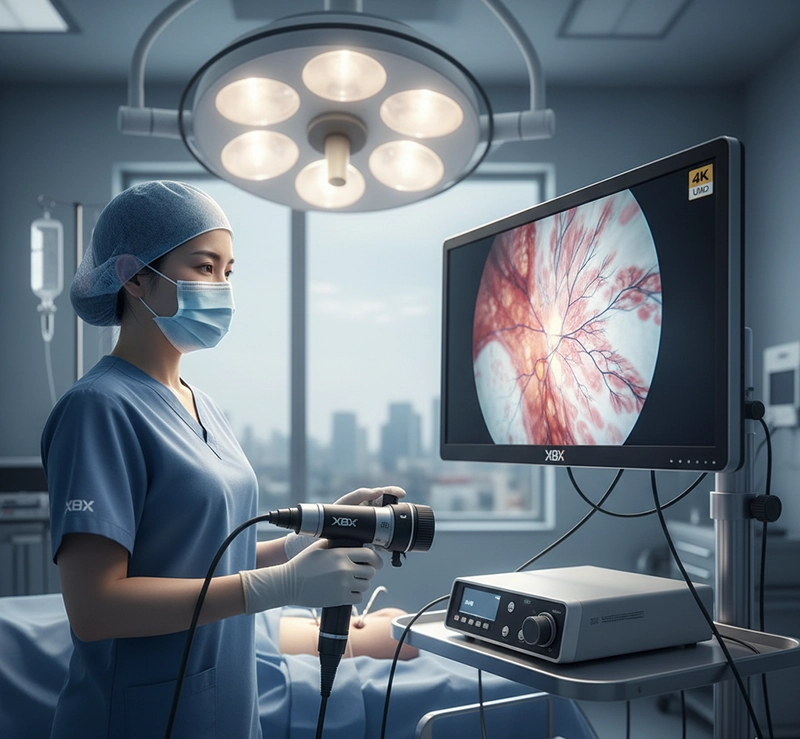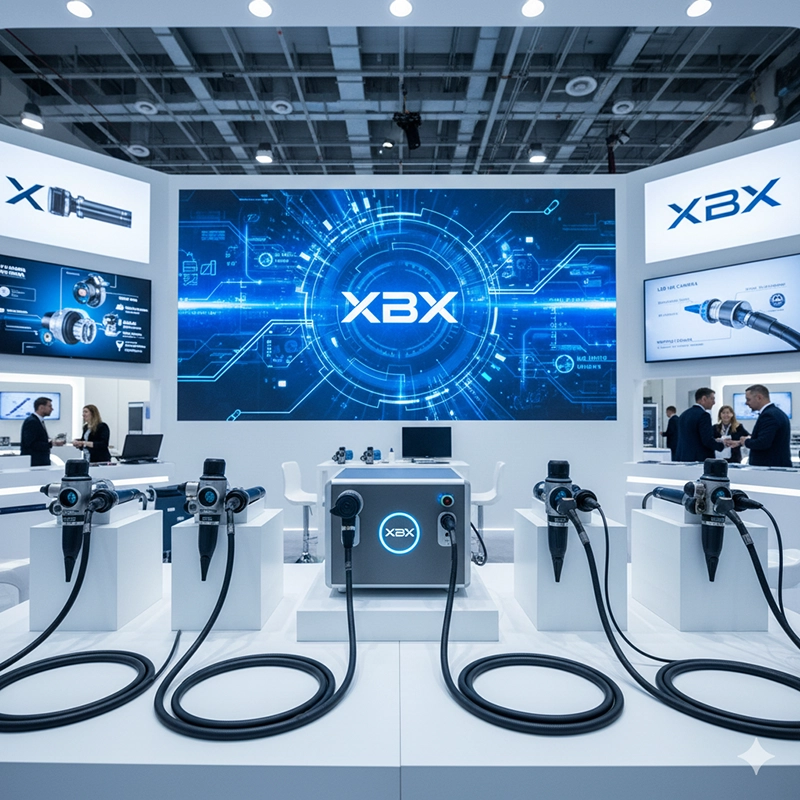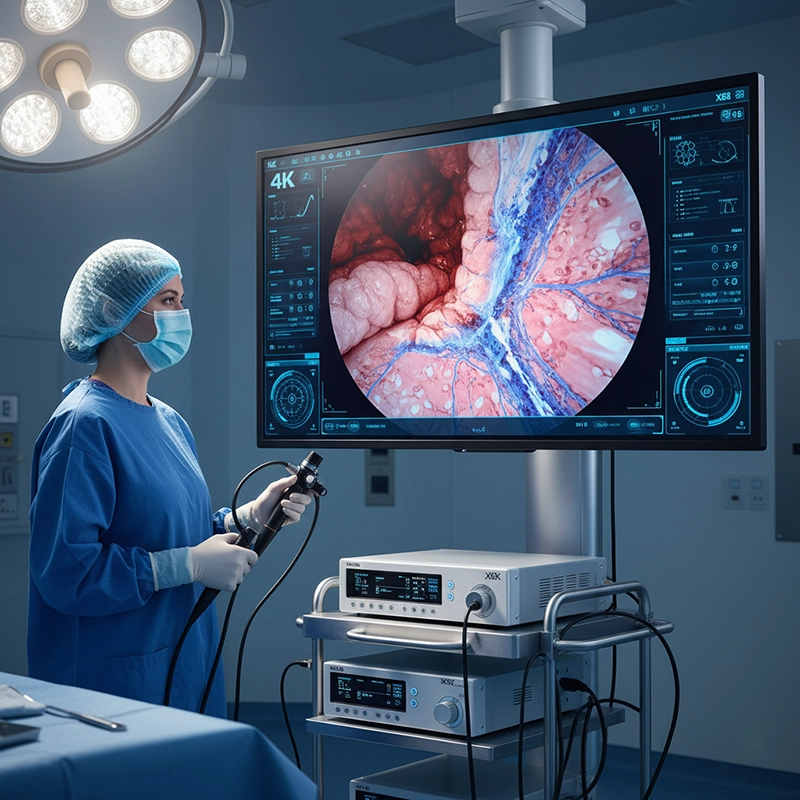Table of Contents
An XBX 4K endoscope is engineered to provide ultra-sharp visualization, low video latency, and robust mechanical durability so surgeons can work with higher confidence and hospitals can run more efficient operating rooms. Built under ISO 13485 and ISO 14971 controls, the 4K endoscope camera, processor, and illumination chain are calibrated as a system to deliver stable color, fine microvascular detail, and reliable performance through repeated sterilization cycles.
The imaging pipeline has been optimized so every pixel conveys usable clinical information. Compared with ordinary HD devices, the XBX 4K endoscope resolves finer edges, improves contrast in low-illumination pockets, and preserves texture cues that guide delicate dissections. Surgeons receive a more lifelike view, which supports confident decisions during minimally invasive procedures.
Back-illuminated CMOS sensors capture high signal with reduced noise, enabling crisp 4K detail in deep cavities.
Rod-lens assemblies are aligned with micron-level jigs so center-to-edge sharpness remains uniform across the frame.
Anti-reflective coatings and hydrophilic distal windows reduce glare and fogging, keeping images clear during irrigation.
Gamma curves and white balance targets are tuned to surgical tissue tones so bile ducts, vessels, and fascia remain distinguishable.
Wide dynamic range processing preserves highlights while lifting shadow detail, limiting blown-out hotspots around specular reflections.
Factory color charts and MTF sweeps are stored per serial number to ensure reproducibility across operating rooms.
Motion-to-photon delay is minimized so instrument tips track precisely on the display. The combination of high frame rate output and efficient codec paths supports accurate suturing, clipping, and cautery in time-critical steps.
The 4K endoscope is part of a complete endoscope system that integrates processor, light source, and display connectivity. Setup has been simplified so staff can standardize room configurations and accelerate turnovers between cases.
Native 4K output is available via 12G-SDI and HDMI 2.0 for seamless connection to surgical monitors and recorders.
Dual-screen modes enable side-by-side comparison, picture-in-picture, and overlay of vital parameters.
DICOM and network archiving support direct case documentation into PACS and hospital EMR systems.
LED light engines are stabilized for color temperature and intensity, providing consistent brightness throughout long cases.
Fiber coupling is verified for throughput so light falloff is minimized even with narrow-angle optics.
Auto-exposure and manual iris modes give surgeons flexible control over scene brightness without sacrificing detail.
Lightweight camera heads, balanced cabling, and intuitive button mapping reduce hand strain. Sterile-field controls allow quick adjustments to gain, white balance, and freeze/capture so scrub nurses and surgeons maintain focus on the operative field.
Mechanical strength and sealing are critical in real-world hospital use. Ordinary products often drift in alignment or suffer seal degradation under repeated reprocessing. The XBX 4K endoscope maintains optical concentricity and channel integrity through validated stress profiles, protecting image quality and extending service intervals.
Stainless coil reinforcement and multi-layer polymer sheathing resist torsion, crush, and abrasion during handling.
Distal lens bonding and gasket materials are qualified against detergents and sterilants common to AER workflows.
Valve seats and channels are engineered with controlled roughness to reduce wear and ease cleaning.
Thermal and chemical cycling is simulated to thousands of runs so optical alignment and seal compression remain stable.
Helium and submersion leak tests screen each unit prior to shipment to prevent microleaks that raise infection risk.
IFU-validated parameters provide clear guidance for temperature, detergent concentration, and drying, reducing variability.
Modular subassemblies, standardized connectors, and digital calibration files enable faster service turnaround. Hospitals keep rooms productive because troubleshooting and restoration to factory performance proceed quickly at authorized centers.
Testing has been structured to mirror surgical reality. Optical, electrical, and mechanical verifications are combined with transport and storage challenges to ensure the 4K endoscope arrives and operates to specification.
Resolution targets, distortion grids, and color checkers confirm sharpness and hue accuracy before release.
Edge enhancement and noise reduction parameters are bounded to prevent artifacts that can mislead clinical judgment.
Long-run burn-in tests validate image stability during extended procedures.
Leakage current, insulation resistance, and grounding continuity are verified to IEC 60601-1 requirements.
EMC testing ensures reliable operation beside electrosurgical units, pumps, and navigation systems.
Thermal monitoring protects sensors and LEDs from heat buildup in prolonged use.
Shock and vibration profiles validate packaging that protects distal optics in global shipments.
Humidity and temperature cycling confirm storage resilience before first clinical deployment.
Post-transport verification rechecks optical centration to guarantee ready-to-use performance.
Clinical teams seek clarity and control, while administrators focus on uptime and predictable costs. The XBX 4K endoscope addresses both by raising diagnostic confidence and reducing rework, all while lowering total cost per procedure through extended lifespan and fast service restoration.
Higher case throughput from faster setup and stable image quality that limits delays.
Lower total cost of ownership via durable materials and efficient service models.
Documentation completeness and UDI traceability that simplify audits and accreditation.
Finer microstructure visibility supports precise dissection, suturing, clipping, and hemostasis.
Low latency preserves hand-eye coordination for delicate maneuvers in narrow fields.
Consistent color and brightness reduce cognitive load and shorten the learning curve across rooms.
Improved detection of subtle lesions may reduce repeat procedures and associated risks.
Efficient workflows shorten anesthesia time and overall recovery pathways.
Stable sterilization performance supports strong infection-control outcomes.
The XBX 4K endoscope demonstrates how precise optics, tuned color science, and resilient engineering can raise surgical performance while keeping operating rooms predictable and efficient. By combining image integrity with practical serviceability, the system helps hospitals deliver consistent, high-quality care across a full spectrum of minimally invasive procedures.
The XBX 4K endoscope provides four times the resolution of standard HD devices, revealing finer anatomical details and microvascular patterns. This improved clarity enhances surgical precision and helps reduce errors during minimally invasive procedures.
Each 4K endoscope is calibrated under strict ISO 13485 and ISO 14971 controls. Every optical component undergoes distortion mapping, color calibration, and modulation transfer function (MTF) verification to guarantee consistent brightness, color accuracy, and sharpness across all units.
Yes. The XBX 4K endoscope supports standard 12G-SDI and HDMI 2.0 outputs, allowing seamless connection to existing medical displays, processors, and recording systems in the operating room.
Absolutely. The device’s multi-layer polymer sheathing, stainless reinforcement, and adhesive bonding have been validated through thousands of autoclave and AER cycles. Its seals and lenses retain alignment and clarity even after prolonged reprocessing.
Copyright © 2025.Geekvalue All rights reserved.Technical Support:TiaoQingCMS